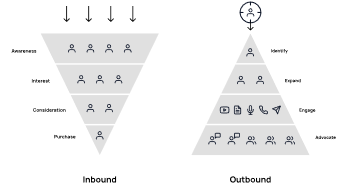Account Based Marketing (ABM) is a specific strategy to scale your demand generation that is essential for B2B SaaS companies. ABM is a term that has become popular in the past 10 years, but is not really a new concept. ABM basically is the new term that combines enterprise marketing—focused on larger accounts with complex B2B buyer’s journeys—with outbound outreach and nurture campaign tactics that use modern digital marketing technologies.
ABM concentrates sales and marketing resources on a clearly defined set of target accounts within a market and employs personalized campaigns designed to resonate with the individuals within each account. With ABM, your marketing message, channel, and timing are based on the specific attributes and needs of the people and accounts you are targeting, hence the name.
I have found that ABM is often the missing piece for young SaaS companies in the early stages of their go-to-market. With the popularity of inbound marketing (thou shalt not spam, interrupt, etc.), and the perceived cost of doing ABM, it is often not considered a tactic until companies have a larger sales team and budget. Even if a founder believes this is a good tactic, it is usually hard to find people or agencies who know how to do this for smaller companies. ABM is often seen as expensive, red-carpet marketing targeting Fortune 500 accounts that only big companies like Microsoft or Salesforce can afford.
I believe ABM is a critical component of an (early stage) SaaS company. Whether it is to get you to product-market fit, or to expand your go-to-market channels and reach, there is a place for ABM in each part of your journey—especially for companies who are creating a new category or developing a new niche in an existing market. You cannot do so successfully without “knocking on some doors.”

When founders, CEOs and board members tell me they need to drive brand awareness for their great solution (“if only people would know about us and find us it is easy to get them to sign-up and pay”), I usually discuss ABM as an alternative with them. Driving broad brand awareness is costly, and unlikely to bring success. ABM is targeted and can help you test, confirm, and execute your ICP, value proposition and messaging and go-to-market approach.
Comparing inbound and outbound, is like comparing putting out nets for fish to swim in, vs. going out with a harpoon to catch the exact fish you want. While the inbound approach is cheaper to scale, and leads to higher conversion rates faster (since prospects have already found you and swam into your net), the outbound approach, when done well, will yield better fitting customers who will likely pay you more over time, and stay longer.
Meet them where they are
The challenge with inbound marketing is that it expects your audience to do the work. They must become aware of a challenge they face and turn this into a need that drives them to start an inquiry. Short of someone reaching them through word-of-mouth marketing, you are relying on your audience to type something into a search engine to find you, either through paid ads, organic search results or the social equivalent of those. Content marketing focused on education, awareness and thought leadership are the best bets you have for people to find you inbound, usually in the middle of their journey, the consideration phase.
Even in this consideration phase, you will only meet your audience if they happen to engage with your content or advertisement. Of course, these inbound leads are very valuable because they will close faster, and are relatively cheap, but the process also leaves you with less control over the early stage of the funnel. It means that the awareness of a need must be discovered by your audience. Especially when you are creating a new category, or have a new approach to an existing need, this may depend on you doing some form of awareness building.
Companies who realize the above conundrum, and decide to attempt to reach the audience, sometimes fall in the trap of doing traditional outbound marketing, where they try to turn the sales pitch into an email campaign or do cold calls trying to convince the audience of their superpowers. This usually falls flat on its face since your audience is not aware of a need they have, and thus are not ready for you to start selling them. This is illustrated with the gap in the “outbound” swim lane in the following diagram.

The solution is to meet your audience where they are in their journey. As you realize they still need to become “problem aware,” your content must be extremely relevant for the things they care about. You can only achieve this by being laser focused on the personas who fit your ICP and thus are likely to recognize the challenges you solve for others. You also need to speak their language and use their “code.” You need to focus on the people who are most likely to really see the benefits from a conversation with you, either now or in the future.
Play the long game
ABM is about marketing, not about sales. Hence, it is called account-based marketing. The people you reach are, by definition, not ready to buy. As they become problem aware, they might allow you to keep nurturing them and educate them. That is really all you can hope for as a first step.
As you cultivate your digital relationship with them through high-quality nurture, you can influence how important the need you solve for is, and you will be top of mind when they are ready to consider their options to solve for that need.
ABM is about leading a prospect down the purchase path as a trusted guide. As such, it takes time. You must be willing to play the long game.